Order-6 square tiling
| Order-6 square tiling | |
|---|---|
 Poincaré disk model of the hyperbolic plane | |
| Type | Hyperbolic regular tiling |
| Vertex configuration | 46 |
| Schläfli symbol | {4,6} |
| Wythoff symbol | 6 | 4 2 |
| Coxeter diagram | |
| Symmetry group | [6,4], (*642) |
| Dual | Order-4 hexagonal tiling |
| Properties | face-transitive
|
In geometry, the order-6 square tiling is a regular tiling of the hyperbolic plane. It has Schläfli symbol of {4,6}.
Symmetry
This tiling represents a hyperbolic
This bicolored square tiling shows the even/odd reflective fundamental square domains of this symmetry. This bicolored tiling has a wythoff construction t1{(4,4,3)}. A second 6-color symmetry can be constructed from a hexagonal symmetry domain.

|

|
| [4,6,1+] = [(4,4,3)] or (*443) symmetry |
[4,6*] = (*222222) symmetry |
|---|
Example artwork
Around 1956,
The artwork seen below has an approximate hyperbolic mirror overlay added to show the square symmetry domains of the order-6 square tiling. If you look closely, you can see one of four angels and devils around each square are drawn as back sides. Without this variation, the art would have a 4-fold
Related polyhedra and tiling
This tiling is topologically related as a part of sequence of regular polyhedra and tilings with vertex figure (4n).
| *n42 symmetry mutation of regular tilings: {4,n} | |||||||||||
|---|---|---|---|---|---|---|---|---|---|---|---|
| Spherical | Euclidean | Compact hyperbolic | Paracompact | ||||||||
 {4,3} |
 {4,4} |
 {4,5} |
 {4,6} |
{4,7} |
{4,8} ... |
 {4,∞} | |||||
This tiling is topologically related as a part of sequence of regular tilings with order-6 vertices with
| Regular tilings {n,6} | ||||||||
|---|---|---|---|---|---|---|---|---|
| Spherical | Euclidean
|
Hyperbolic tilings | ||||||
 {2,6} |
 {3,6} |
 {4,6} |
 {5,6} |
 {6,6} |
 {7,6} |
{8,6} |
... |  {∞,6} |
| Uniform tetrahexagonal tilings | |||||||||||
|---|---|---|---|---|---|---|---|---|---|---|---|
[6,4], (*642 )(with [6,6] (*662), [(4,3,3)] (*443) , [∞,3,∞] (*3222) index 2 subsymmetries) (And [(∞,3,∞,3)] (*3232) index 4 subsymmetry) | |||||||||||
= = = |
= |
= = = |
= |
= = = |
= |
||||||

|
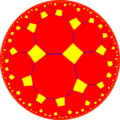
|

|

|
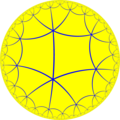
|

|
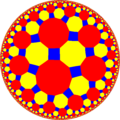
| |||||
| {6,4} | t{6,4} | r{6,4} | t{4,6} | {4,6} | rr{6,4} | tr{6,4} | |||||
| Uniform duals | |||||||||||
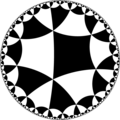
|

|

|

|

|
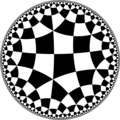
|
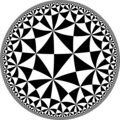
| |||||
| V64 | V4.12.12 | V(4.6)2 | V6.8.8 | V46 | V4.4.4.6 | V4.8.12 | |||||
| Alternations | |||||||||||
| [1+,6,4] (*443) |
[6+,4] (6*2) |
[6,1+,4] (*3222) |
[6,4+] (4*3) |
[6,4,1+] (*662) |
[(6,4,2+)] (2*32) |
[6,4]+ (642) | |||||
= |
= |
= |
= |
= |
= |
||||||

|

|

|

|

|

|

| |||||
| h{6,4} | s{6,4} | hr{6,4} | s{4,6} | h{4,6} | hrr{6,4} | sr{6,4} | |||||
| Uniform (4,4,3) tilings | ||||||||||
|---|---|---|---|---|---|---|---|---|---|---|
| Symmetry: [(4,4,3)] (*443)
|
[(4,4,3)]+ (443) |
[(4,4,3+)] (3*22) |
[(4,1+,4,3)] (*3232) | |||||||

|

|

|

|

|
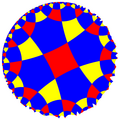
|

|

|

|

|
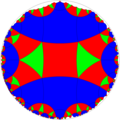
|
| h{6,4} t0(4,4,3) |
h2{6,4} t0,1(4,4,3) |
{4,6}1/2 t1(4,4,3) |
h2{6,4} t1,2(4,4,3) |
h{6,4} t2(4,4,3) |
r{6,4}1/2 t0,2(4,4,3) |
t{4,6}1/2 t0,1,2(4,4,3) |
s{4,6}1/2 s(4,4,3) |
hr{4,6}1/2 hr(4,3,4) |
h{4,6}1/2 h(4,3,4) |
q{4,6} h1(4,3,4) |
| Uniform duals | ||||||||||

|

|

|
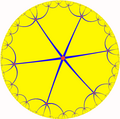
|
|||||||
| V(3.4)4 | V3.8.4.8 | V(4.4)3 | V3.8.4.8 | V(3.4)4 | V4.6.4.6 | V6.8.8 | V3.3.3.4.3.4 | V(4.4.3)2 | V66 | V4.3.4.6.6 |
| Uniform tilings in symmetry *3222 | ||||
|---|---|---|---|---|

|
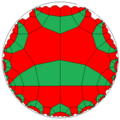
|

|

| |

|

|

| ||

|

|

| ||
See also
References
- ^ Conway, The Symmetry of Things (2008), p.224, Figure 17.4, Circle Limit IV Archived 2012-07-17 at the Wayback Machine
- ISBN 978-1-56881-220-5(Chapter 19, The Hyperbolic Archimedean Tessellations)
- "Chapter 10: Regular honeycombs in hyperbolic space". The Beauty of Geometry: Twelve Essays. Dover Publications. 1999. LCCN 99035678.
External links
- Weisstein, Eric W. "Hyperbolic tiling". MathWorld.
- Weisstein, Eric W. "Poincaré hyperbolic disk". MathWorld.
- Hyperbolic and Spherical Tiling Gallery
- KaleidoTile 3: Educational software to create spherical, planar and hyperbolic tilings
- Hyperbolic Planar Tessellations, Don Hatch
- GenusView 0.4 preview View of {4,6} hyperbolic tiling, and matching 3D torus surface.



